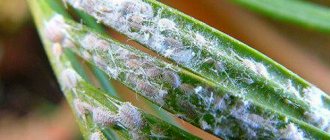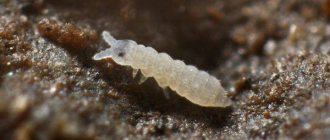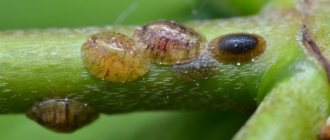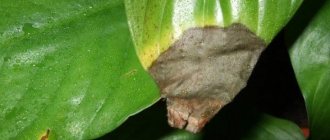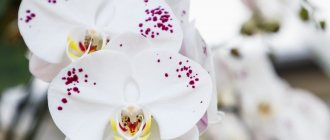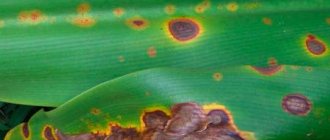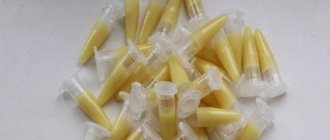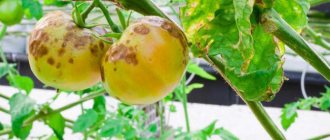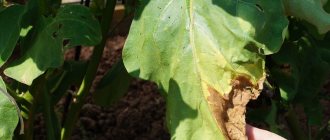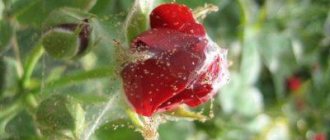Dry air is what immediately comes to mind when we see dry tips on indoor plants. But not everything revolves around humidity. There are other reasons why yellow or brown spots appear on leaves.
Every gardener has encountered the problem of dry leaf tips in indoor plants at least once. It doesn’t matter whether you grow begonias, spathiphyllum, roses or orchids. At the same time, potted flowers do not show other alarming symptoms, continuing to grow and even blooming. Let's try to figure out why the tips of the leaves of indoor plants dry out, whether it is dangerous and how to eliminate the defect.
Most often, yellow, brown and even black dry tips are the result of improper care or a reaction to the activity of pests. The process of natural aging cannot be ruled out. True, the latter can be delayed by creating the most comfortable conditions for the green pet.
Diagnosis is an important stage for prescribing the correct “treatment”
joygarden.com
To determine why the leaf tips of spathiphyllum, geranium and other plants turn yellow and dry, diagnose the condition of your green pet. The complexity of the procedure lies in the fact that the search for the cause most often has to be carried out from the opposite direction, i.e. by exclusion method.
- Make sure that the depressed state of the plant is not caused by pests . They like to hide on shoots and on the undersides of leaves, so inspect these places especially carefully. Parasites can also be on the roots. But don't rush to check it out. Perhaps the reason is completely different, and you will only damage the root system in vain.
- Assess the hardness of the water used for irrigation . If you do not settle tap water before watering, plants may suffer from high levels of salts, fluoride, chlorine and other heavy substances that change the characteristics of the soil, making the substrate uncomfortable.
- Compare your fertilization schedule to the recommended fertilization schedule . The reason why the leaves of palm trees, dracaena, ficus, orchids and other crops dry out may be frequent or, conversely, rare feeding.
- Measure air humidity levels . Assess how much air humidity in your apartment is suitable for moisture-loving species.
- Analyze whether the plant is cramped in the pot . One of the alarm bells may be roots emerging from the drainage hole.
- Determine the moisture content of the substrate and the degree to which it dries out between waterings . This can be done either by touch or using indicators that are sold in flower shops.
If you find a deviation from the norm in just one point, the cause of dry ends is usually easy to eliminate. But if, after a preliminary analysis, you see several problems at once, you will have to take comprehensive measures.
Why do the tips of leaves on indoor plants dry out?
The causes of dry leaf tips in indoor plants can be caused by many factors. It is important to understand that each indoor flower requires an individual approach and care. Some prefer high humidity and diffused light, while others feel great with minimal watering and in the most illuminated place in an apartment, house or office.
Houseplants
The most common causes of dry tips in most plants are:
- Watering with tap water.
Tap water contains many impurities, in particular, it contains significant concentrations of fluorine and chlorine, which make it too hard for irrigation.
- Waterlogging of the soil.
Almost all plants do not like excess moisture. If water comes in in large quantities and stagnates in the pot, the roots begin to rot and the leaves turn yellow.
In this case, the number of waterings is reduced to a minimum in order to get rid of stagnant water in the root system.
Important! To reduce the risk of rotting of the root system, it is recommended to use drainage when planting a plant in a container.
On the other hand, lack of watering leads to the soil drying out, the amount of necessary macro- and microelements decreases, and the tips of the leaves of indoor flowers dry out.
- Pests.
Attacks by insect pests can provoke the appearance of diseases and, as a result, dry leaves on flowers. To avoid this problem, preventive measures should be taken: treat the plant with special insect repellents and feed it with fertilizers to increase immunity.
Also, for preventive purposes, once every 10 days it is recommended to wipe the surface of the leaves of indoor flowers with a cloth soaked in a soap solution.
- The indoor air is too dry.
For some flowers, air humidity is extremely important.
Attention! It is noteworthy that one of the common mistakes is the belief that when humidity is low, the amount of watering should be increased.
- Frequent use of fertilizing and fertilizers.
Excessive fertilizing can also cause drying of the leaf tips of indoor plants. It all depends on the perception of the fertilizer and its composition. If the salt content is high, the fertilizer can burn the roots of the flower, and this, in turn, will cause the leaf edge to darken.
Let's look at some of the reasons in more detail below.
Let’s start “treating” indoor flowers: general rules
mysunnybrighthome.com
Regardless of the reason why the leaves of anthurium, Kalanchoe or chlorophytum dry out, any plant could use emergency help, which consists of the following:
- Replacing the surface layer of soil with fresh substrate . This will reduce the risk of soil contamination and eliminate salt deposits from hard water.
- Cleaning the surface of leaves from dust . For plants with delicate leaves, this can be done using a shower. If the leaves are denser and not prone to mechanical damage, use a soft cloth.
You should avoid bathing in the shower if the leaves of plants have edges (such as those of violets).
- Change in air humidity . Spraying, a humidifier, or a regular container of water placed next to the flower will help with this.
If you suspect that the plant has been flooded, do not increase the humidity until the soil dries out.
- Revisiting principles of care . Make sure the plant is getting exactly what it needs from you. Each green pet is individual, and therefore, the care program needs to be selected individually.
Leaf tips dry out due to improper watering
Why do the leaves of indoor flowers turn yellow - what to do?
Leaves will dry out if watered too much. Excessive watering provokes acidification of the soil, which leads to rotting of the roots. If you continue this process, the flower will die.
The appearance of brown spots along the edges of leaves is called necrosis. With this disease, tissue partially dies. This phenomenon occurs because some of the roots die. For this reason, the flower ceases to receive the substances required for development.
Dry spots on the edge, which appeared due to rotting of the rhizome, are much darker than those spots that are associated with insufficient watering and low air humidity. In the latter case, these will be bright yellow or light stripes.
Excessive watering as a cause of drying out
Necrosis from the edges of the leaves is associated with improper watering. The soil in the pot does not have time to dry out, air does not reach the roots, which is why putrefactive microorganisms begin to multiply. This condition is aggravated by cool air temperatures, as well as the location of the pot in a cold place.
During the warm summer season, many species require abundant watering. However, when it gets cold in autumn and winter, flowers need to be watered less frequently to prevent rotting of the roots and, as a result, drying out.
It can also be a problem if you fertilize too much. Most flowers stop actively growing in autumn and winter, so they need much less additional feeding.
Note! If you continue to fertilize, the soil will become sour and salty, which will greatly damage the roots. In a situation where a flower needs to be watered all year round, it is worth creating warm conditions to prevent the earth from cooling and the presence of drafts.
Reason #1. Dry air in the apartment
gardenista.com
Many representatives of tropical latitudes, for whom warmth and high humidity are the norm, have moved to live in our apartments. But creating such conditions at home can be extremely difficult, especially during the heating season, when the already dry air dries out completely.
Don’t think that you can save the situation by increasing watering. By doing this, you will only achieve rotting of the root system, and therefore, the leaves will receive even less moisture.
The following methods will help increase humidity:
- Spraying . It is advisable to irrigate the leaves with a spray bottle at least 2-3 times a day. Otherwise, this measure will be ineffective.
Spraying is not suitable for plants with blooming flowers (drops falling on the inflorescence can cause it to wilt), as well as for species with pubescent leaves.
- Use of humidifiers indoors . Using a humidifier you can very quickly increase the humidity to the desired level.
- Place the pot on a tray into which wet moss, pebbles or expanded clay are placed in advance . The bottom of the pot should not come into direct contact with the liquid. Moisture from the pan will evaporate, increasing the humidity locally.
embarkgarden.com
- Finding a new place for plants, away from heat sources . If possible, install regulators on the radiators so that the heating intensity can be reduced.
- Temporary transfer to the bathroom or kitchen . In these rooms the air humidity is always higher than in other parts of the house.
The tips of the leaves dry out due to dry air
Another reason for dry ends is low air humidity. In winter it can be less than 30%. Most plants require humidity in the region of 50-60%, for capricious tropical species - 80-90%.
Pests of indoor plants and diseases of indoor flowers
For those species from the tropics that love moisture, it is necessary to create special conditions that are closest to natural. First of all, you need to increase the air humidity. For these purposes, spray the leaves, wipe them with a damp cloth, and wash them in the shower. These procedures alleviate the condition of the flower for a short period. To create a humid atmosphere around the pot, you need to place it in a wide tray. Place wet pebbles, expanded clay or moss in the tray. This will allow moisture to evaporate for a long time, and a favorable climate will be created around the plant.
It is also possible to increase the humidity by placing the pot in a wide planter. The gap between the containers must be filled with damp moss. To humidify the air in a room, you need to use electric humidifiers, fountains, or hang wet rags on hot radiators.
Flowers from the tropics are very delicate. It is prohibited to place them near operating heating appliances. Under a stream of hot air, the flower shrinks and begins to turn yellow. In addition, the ends begin to dry out due to drafts when doors or windows are open. High humidity is required for azaleas, ferns, and some indoor palm trees.
Note! Species that can tolerate dry air include cacti and succulents. They have special protection against moisture evaporation: a coating in the form of wax, a dense shell, and pubescence.
Reason #2. Watering indoor plants with hard water
Tap water is usually too hard to water plants with. Moreover, even when settled, green pets do not always like it, because... may contain a lot of salts.
If the reason why the leaves of spathiphyllum, begonia, dracaena, and roses dry along the edges lies in the quality of water, you can suspect the problem by a white coating on the top layer of soil. In this case, you need to proceed as follows.
- Remove plaque (if any) . Try not to damage the root system. Add fresh substrate to the pots.
- Check in the reference book what the plant prefers to “drink” . Perhaps he needs particularly soft or slightly acidified water.
- Avoid watering with running water completely . Be sure to let tap water sit for at least 24 hours (preferably several days). It would be a good idea to strain the liquid before use. If the hardness of even settled water is not suitable for plants, replace it with boiled, melt or rain water.
Leaf tips dry out due to water quality
Leaves may dry out due to poor water quality. It is necessary to change the watering process:
- It is worth clarifying what kind of water is recommended to water the plant. It may require acidified or particularly soft water;
- Do not water the flower with running water. It should be left for at least a day. It is best if the water sits in the container for several days. After settling, the water is filtered;
- Tap water can be replaced with melted water, rain water or boiled water.
Reason #3. Violation of the plant watering regime
businessinsider.com
When asked why the tips of leaves dry out on dracaena, “female happiness,” anthurium, and arrowroot, they usually answer that the plant is overdried. However, not only excessive drought, but also excessive watering can cause this cosmetic problem.
Most indoor plants tolerate temporary “drought” much better than overwatering.
Sometimes it is difficult to understand whether a plant is flooded or too dry. When overmoistened, the leaves lose turgor and look lethargic and lifeless. They seem to be lacking moisture. This is true. The only reason is that the root system is rotten, which means it cannot deliver water to the leaves.
The lower the air temperature in the room, the more dangerous is overwatering.
If you suspect that you have dried out or overwatered the plant, follow our recommendations.
- Check the plant's water needs. Find out whether it needs scanty or abundant watering, and whether it matters if the soil clod dries out between waterings. Also check which method of watering the flower prefers - standard or in a tray.
- Analyze the quality of drainage and drain holes . Overmoistening, which results in rotting and deterioration of the air permeability of the soil, can be caused by a hole in the pot that is too small or a lack of drainage. If so, repot the plant. If there are no problems with drainage, let the earthen ball dry out almost completely, and only then water the plant.
- During drought, water more often and more abundantly . But do not let the liquid stagnate in the pan. Carry out the next watering after at least a few inches of the top layer of soil have dried out - for moisture-loving crops and after the middle layer of soil has partially dried out - for succulents and other low-drinking species.
- Consider buying a pot with self-watering . This invention will save you from the hassle of individually selecting the frequency of watering for each plant.
- Buy a soil moisture meter . Use the device every time before watering to understand how much water the plant needs.
You can water a flower regularly, but it will still suffer from thirst if the amount of water remains insufficient. The surface of the soil may remain wet, but the liquid will not reach the roots. It is not difficult to make sure that moisture reaches the roots. Just pour water until it starts to seep into the pan.
Due to violation of the containment regime
The last reason why the tips of the leaves of houseplants begin to dry is the wrong conditions for keeping the green pet. House flowers require individual care and individual conditions of maintenance, which are dictated by their physiological properties. A certain temperature regime must be maintained in the room, as well as a certain lighting and humidity. It is necessary to ensure that the plant in the pot feels very comfortable and is not cramped there.
An important point is the correctly selected fertilizer regime. Most often, the reason why the tips of the leaves of indoor plants dry out is due to improper use of fertilizers. The appearance of a white or gray coating on the soil surface is a typical situation for this problem. In this case, the yellowed tips acquire a reddish or brown tint.
To solve the problem with the tips drying out, you need to restore the conditions necessary for the flower. And then indoor plants will delight the eye with their appearance for a long time.
Reason #4. Plant oppression by pests
myhouseplants.com
If pests are noticed on the leaves or stems, this may be the main cause of the yellowed tips. The parasites drink the cell sap, thereby infecting the leaf. In this case, treatment measures must be taken as quickly as possible, because The problem may not be limited to dry ends alone. In addition, the plant can infect its healthy neighbors.
In addition to parasites such as aphids, scale insects, and spider mites, gardeners should also be wary of fungal diseases. They destroy leaf after leaf until the plant is completely destroyed. The fungus can often be recognized by the brown spots that accompany wilting and drying of the leaves.
Complex therapy includes the following stages:
- isolation of the diseased plant from other crops;
- washing the leaves with soapy water;
- increased air humidity;
- application of insecticides;
- disinfection of pots before replanting.
Since the diseased plant may have come into contact with other crops, strengthen safety measures for other indoor flowers.
The best protection against pests is prevention of their occurrence. Therefore, always treat the pots before planting, use only packaged soil or calcine garden soil. And never place recently purchased flowers next to the permanent inhabitants of your home flower garden. Isolate “new arrivals” for at least a month to ensure they are healthy.
Leaf tips dry out due to pests
If the tips of a house plant begin to turn black due to pests, then comprehensive measures must be taken:
- isolating the flower from others so that pests do not spread;
- the leaves must be washed with soapy water;
- it is necessary to increase air humidity;
- It is worth using special pest control products;
- before replanting, thorough disinfection of the pot is necessary;
- carry out preventive measures.
Pests as a cause of drying out
Reason #6. Lack of light or direct sunlight
gardeningknowhow.com
Incorrect placement can also cause leaf tips to turn black. Moreover, both too bright light (direct sunlight) and lack of lighting lead to a similar result.
When trying to understand why the leaves of flowers dry out, it doesn’t hurt to analyze whether direct sunlight burns the plant. This provokes the appearance of not only brown tips, but also entire spots. This phenomenon occurs especially often after spraying on a sunny day.
Yellowing due to lack of light looks different. It manifests itself as an uneven loss of color and may be accompanied by the dropping of leaves (hibiscus behaves this way most often).
- Find out which window (north, east, southwest, etc.) the flower prefers to grow on, and try to find a suitable place for it.
- If it is not possible to place the pot on a bright window, get an additional lamp. This can be a special phytolamp or a regular fluorescent one.
- If the leaf tips are turning yellow on only one side of the flower, try rotating the pot from time to time to ensure all shoots receive enough light.
- Protect the plant from bright sunlight using blinds or regular cardboard (its size should correspond to the height of the flower), which should be placed between the window and the flower pot during the daytime.
Lighting problem
Finding a flower in a place exposed to direct sunlight causes burns on its leaves, which appear as dry brown spots on the entire leaf blade.
Flower care (Photo used under standard license ©azbukaogorodnika.ru)
Lack of lighting is manifested by yellowing of foliage, uneven loss of color and possible dropping of leaves.
Depending on the reason, it is necessary to either hide the plant behind the blinds or provide it with additional illumination using a phytolamp.
Reason #7. Drafts in the apartment
pngtree.com
The plant can grow quietly in a cool room. But it will react very poorly to sudden temperature changes caused by cold air masses. Drafts are detrimental to almost all indoor flowers. As a result, slightly yellowish spots appear on the leaves, which fade until they become translucent.
The source of drafts and cold air currents can be not only an open window, but also a running air conditioner or fan. Place the pot where the influence of cold air is minimal, and the flowers will again thank you with lush and juicy greenery.
Spraying.
Why are sprayings needed? This technique in indoor floriculture allows you to temporarily increase the humidity and also slightly reduce the temperature. After this, the plant breathes easier and is saturated with oxygen. Overall comfort is improved. Plants that gardeners spray usually grow wider leaves. The decorative effect is slightly increased. But if the basic principles of proper care are not followed, the leaves will dry out even with very frequent spraying. Since this most often does not occur from low humidity, but from the painful state of the plant. In addition, you can spray only at certain times or not at all.
Dracaena
When spraying is recommended:
- You can spray only on clear days.
- Needs to be sprayed in summer.
- You can spray only in the first half of the day.
- It is necessary to spray at air temperatures above +30°C.
When not to spray:
- Do not spray in cloudy or rainy weather.
- Do not spray in the evening or at night.
- Do not spray plants that are in a dormant period. And due to the peculiarities of our latitudes, this period begins in the second half of autumn and continues until spring for the vast majority of plants.
- It is not advisable to spray plants at temperatures less than +22°C. Keep in mind: the temperature on the windowsills is almost always lower than in the rest of the room.
- Do not spray if the window is open during the cold seasons of the year.
- Under no circumstances should you spray a plant that is exposed to direct sunlight.
- It is not advisable to spray plants with pubescent leaves.
In principle, this is generally known information. I bring it up only as a reminder. Based on this, it is easy to conclude that spraying can be done almost only in the summer season, and then not every day.
Reason #8. Incorrect feeding scheme for indoor flowers
semyatut.ru
Excessive care for houseplants often causes yellowing of the tips. This is especially true for those gardeners who like to apply fertilizers, guided by the principle “the more, the better.” As with watering with hard water, a white coating may form on the surface of the substrate, which needs to be removed. Be sure to stop feeding.
Yellow tips can also signal that you have not fed the plant for a long time or have not taken care of its balanced diet. The lack of elements manifests itself in different ways.
- Potassium deficiency : the tips and edges of the leaves turn yellow, but the veins do not change color.
- Nitrogen deficiency : tips and veins turn yellow. The leaves become smaller and gradually lose their color saturation (even turning white).
- Calcium deficiency : leaf tips turn brown, leaves become deformed and curled. The defect occurs in soils that are too acidic or too alkaline.
- Zinc deficiency : Leaves look like they are sunburnt. They lose color. The veins protrude.
- Iron deficiency : leaves turn yellow and become smaller. The veins retain their green color, but become more convex.
If only the tips of indoor plants dry out, and the leaf blade itself remains healthy, this rarely leads to serious problems. Although, of course, all this spoils the appearance of the flower and the mood of its owner. If it's just a matter of dry air, perhaps everything will go away after the end of the heating season. But if the reason is more serious, then you cannot turn a blind eye to the flower’s disease, so as not to aggravate the situation.
Watering.
Depending on the lighting and volume of soil, it is necessary to select the correct watering mode. For example, in a high light intensity environment and a small pot, you will need to water frequently. There are large and short plants. They can be planted in pots of various sizes. Place them on windows of different light intensity. Therefore, the options for watering frequency are almost endless. This is why care recommendations never say how many times a week to water the plant. This must be determined by the grower himself. In general, no one can do this for you.
Basic principles of irrigation.
Most plants grow well in a constantly moist substrate. Some, for example, cyperus and calla lilies, during the period of active growth, require not moist, but constantly wet soil. Azaleas and anthuriums require moisture; even light drying is unacceptable. Succulents require infrequent watering from autumn to spring, but abundant watering from spring to autumn. In general, the frequency of watering should vary in different seasons for all plants. In spring and autumn you need to water depending on the temperature. The lower it is, the less often. In summer there is a lot of light, so you need to water more often. In winter, in our latitudes, the sun shines worse and for less time, as the days become shorter. Accordingly, watering is rarely necessary. If the plants are kept cool, then they need to be lightly moistened occasionally. This cannot even be called full watering. The description of a particular plant always indicates the requirements for substrate moisture.
Why do the tips of leaves dry out? Incorrectly selected watering mode.
Irrigation water displaces air from the pores of the substrate. The longer there is no air in the root area, the stronger the oxygen starvation. This is often the problem with flooded plants. That is, you can even water rarely, but due to weak light, and often due to the large size of the pot, the soil takes a long time to dry. The plant is suffocating. Under these conditions, the roots cannot develop properly. Accordingly, such a root system is not capable of delivering a sufficient amount of water to the leaves. Therefore, lack of water causes the ends to dry out. So, the soil is damp and there is little water in the leaves.
This poinsettia's soil took too long to dry out.
Improper watering
Excessive watering, as well as insufficient moisture, can also cause dry ends.
Excessive moisture leads to rotting of the roots, which immediately affects the appearance of the plant. The tips of the leaves begin to turn black and rot. The plant may die.
Lack of moisture causes the flower to begin to dry out. This also occurs from the ends of the leaves.
- First of all, you need to find out how much water a particular plant needs depending on the conditions in which it is kept and the time of year.
- The pot must have drain holes for excess water. And you should always put drainage (stones or gravel) at the bottom. If this was not done when planting the plant, then it must be replanted taking into account all the recommendations.
- If everything is in order with the drainage and drainage, and the flower is simply flooded, you need to wait until the soil dries out. The next watering should be done as needed.
- If there is a lack of moisture, the amount of watering must be increased. Some plants drink a lot. It all depends on the specific type.
- If possible, it is worth purchasing pots with automatic watering. They will make care easier and eliminate the hassle of individually selecting the frequency of watering your flowers.
What is a substrate
A substrate is a mixture of soil and other components accepted for use in indoor floriculture. It is used for plant stability, maintaining the required level of humidity in the root system zone, and also as a “storehouse” of minerals. That is, the soil is not directly used to nourish the plant. In fact, almost any flower can be grown without soil. By the way, this is used for hydroponic, aeroponic and other types of plant maintenance without soil. Store-bought substrates can vary greatly in moisture holding capacity. And this can affect the appearance of dry ends.
Substrate quality.
Unfortunately, the quality of substrates is constantly decreasing. Nowadays, so-called universal soils are most widely used. This is the most unpredictable option. You can buy soil that will dry out for a very long time in the depths of the pot. And this (if you remember) interferes with breathing, since the accumulation of excess water displaces air. Consequently, under such conditions, the root system slowly degrades and the tips of the leaves dry out. There may be another option. The substrate is poorly wetted. When watering, water does not saturate the soil. In such conditions, the roots receive a lot of air, but the lack of the required amount of moisture naturally does not contribute to their development. As a result, the soil seems to breathe and the watering regime is chosen correctly and the light is good, and the tips of the leaves dry out.
How to improve the quality of the substrate.
Floriculture has been developing for thousands of years. There are techniques for increasing growth and restraining it, ways to enhance flowering and activate it at the right time. Therefore, of course, there are measures to improve the quality of substrates. To improve the structure, sand, gravel, vermiculite, perlite, broken red brick, charcoal, etc. can be added to soils. All these components improve the penetration of water into the soil, improving its wettability. At the same time, they don't hold it well. Accordingly, the substrate quickly becomes airy. The roots are sufficiently moistened and at the same time breathe.
Drainage.
Drainage is a layer of poorly wetted or easily dried material. You can use expanded clay, charcoal, broken red brick, pieces of polystyrene foam, pieces of broken ceramic pots, etc. That is, use any large material. The use of drainage is a technique in floriculture, with the help of which the substrate is additionally saturated with air from the bottom of the pot. As a result, root respiration improves. Accordingly, they develop better, and therefore better supply the leaves with water. This is exactly what we need to prevent their premature drying out. Also, using drainage, you can regulate the volume of substrate in the pot. That is, the larger the drainage layer, the less soil will fit in the container. In this case, it is permissible to use a large pot diameter compared to the size of the plant.
